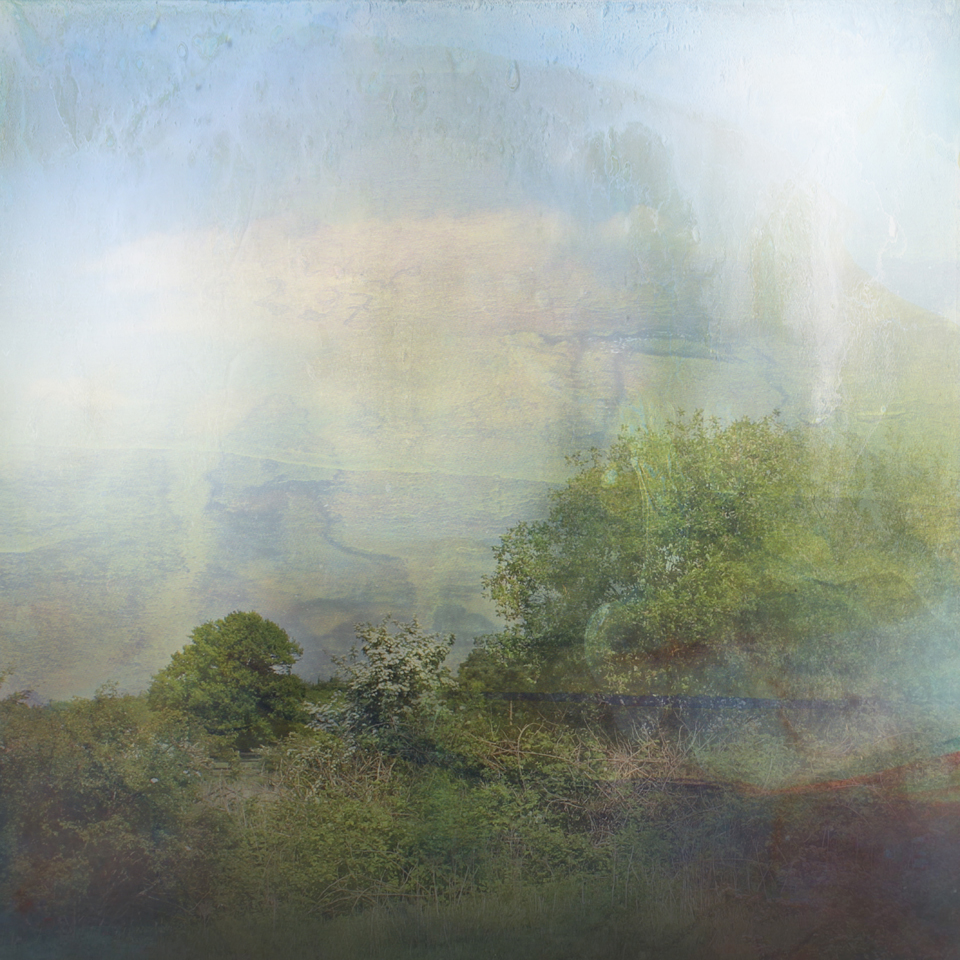Presented at the John Clare conference May 2014, Oxford Brookes University.
Doubling light is the phrase I’ve borrowed from the poet John Clare as the title for my talk. It comes from the November stanza in his poem the Shepherd’s Calendar. He evokes November as a month of misty fog gradually surrendering to the stillness and snow of December. The poem is painterly, especially in the modulations of light and shade, for example its:
‘checker’d moods, Sunshine and shadows,’
At times Clare subverts the light, setting up a surreal confusion between night and day. The sun is swapped with the moon and the day is a dream of night – And then light doubles:
‘The owlet leaves her hiding-place at noon,
And flaps her grey wings in the doubling light;’
This image of ‘doubling light’ is evocative. One is not sure if the light is intensifying or depleting. It could be either or simultaneously both – or it is a twilight zone, leading us to new worlds. Doubling at the very least suggests folding back on itself, veiling and layering.
For me this echoes what happens in the process of layering in painting. Layers both conceal or change what is underneath, but also reveal something else, a new kind of image becoming apparent.
I first encountered Clare through the reading of ecocriticism – where he is centrally important as a poet of the ecological crisis. Ecocriticism discusses the repositioning of cultural activity so that nature is less objectified and more engaged with directly in a responsive and reflective manner.
John Clare is a luminous example of this thinking ‘with’ nature and not ‘about’ nature. There are many instances of where he perceives himself quite deliberately to be part of nature.
Famously –
‘I found the poems in the fields and only wrote them down’. – or when he gives nature a human voice as in the poem ‘Lament of Swordy Well’.
It is the linking of natural reality, imagination and poetics in ecocriticism that makes it relevant to my art practice. Poetry has always had an influence on my work; in the studio I often start my day reading poetry, and I call this: ‘reading into painting’ because I feel this practice opens up channels which prepare me to begin.
Wallace Stevens, the American poet makes a clear link between poetry and painting when he says: ‘……… poetry and painting operate at the juncture between imagination and reality,’ and that: ‘there is a universal poetry, of which literary poetry and painting are manifestations.’
I have looked for an equivalent of ecocriticism in the art world but find that the focus is slightly different. The emphasis in is predominantly on a different trajectory.
There is much on themes of climate change and ecology and the politics of impending environmental disaster, and there is also, of course, work that engages directly with nature. But to me there is not a discourse, that I have found as yet that resonates like eco-criticism. Conceptual art based on philosophy and theory is in the ascendance. This approach tends to subordinate nature to a set of ideas so that creative interpretations and concepts override natural reality itself. Possibly due to a fear of pastoralism, romanticism and being bogged down in ‘landscape’ traditions, there is a resistance to encountering and entering nature thought free. I think about how hard this hit me in 2004 when I first visited Frieze art fair.
Frieze is an annual event in London that has been staged since 2003. It is at the pinnacle of the international art scene and shows work at the cutting edge of contemporary art. It is famously exhausting and this occasion when I visited, was no exception. There was vast amounts of art work, some appealing, some less so – and then, startled and instantly engaged, I saw a tree! It was standing in isolation without a name or label tag, the floor boarding cut to neatly surround the trunk. I felt a moment of relief and delight to find an art piece I was genuinely thrilled by. Who had come up with the idea of exhibiting a living tree? For me, amidst all the art palaver, it had a profound almost hallucinogenic reality and beauty about it.
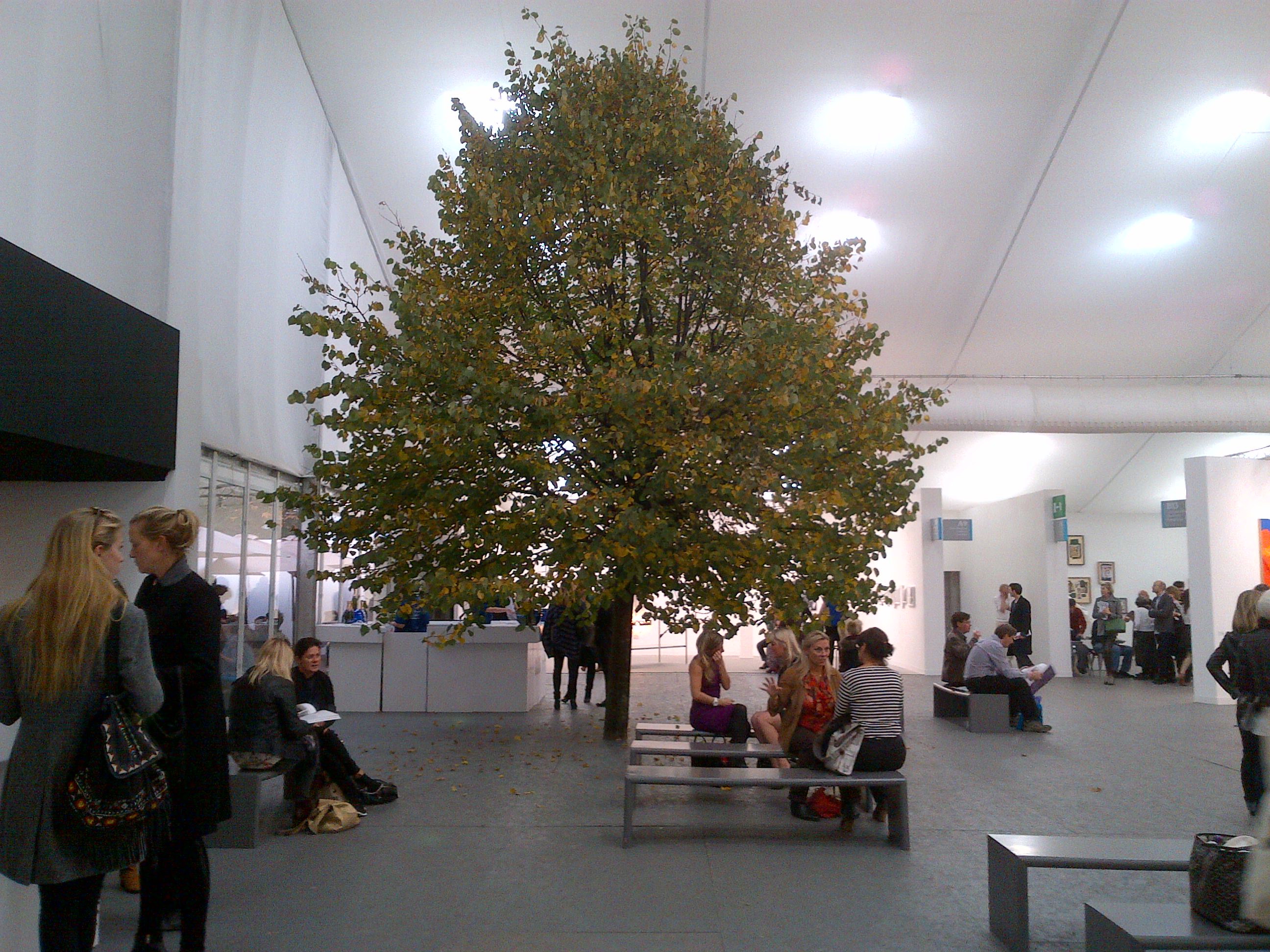
Tree in Frieze art fair
Then it struck me – why is nobody looking at this piece of art? All the people were congregating elsewhere. No one was anywhere near it. I went up and touched it and at that point realised it wasn’t an exhibit at all.
Frieze art fair is staged in Regent’s Park in a gigantic tent where some trees are enclosed when it is constructed. The tree was now housed within this art bonanza but bearing absolutely no relationship to it at all. Because it wasn’t framed by culture, it simply wasn’t being looked at. There was a weird discordant sense that because it didn’t inhabit the mental space of this environment, it didn’t exist. Except that it did, and in protest was almost outlandishly radiant.
Whilst trying to find paths in an art world that sometimes seems, oddly, to exclude nature I find in ecocriticism an approach to which I readily accord, and which happily also brings access to the world of literature. John Clare’s poetry in particular has become a rich resource.
To me, his poetry more than describes nature, it evokes it. His poems are kinetic, relating multiple incidents, darting hither and thither as if he is trying to encompass all the detail. The month of July in the Shepherds Calendar is a good example. It is a busy poem where:
‘The very landscape reels with life’
Everything must be honoured from tiny insects climbing reeds, to the sun setting in the west. From the sounds and smells, youngster’s games and colours, it is a racket. It goes from microcosm to macrocosm and back, and becomes filmic in what it conjures up. A moving image. It incrementally layers and rhythmically weaves not only landscapes but a sense of living nature.
There is quiet attention too, as in ‘the nightingale’s nest’ when he sees the nightingale and knows that if he makes a sound, all will stop and the nightingale will fly away. It becomes a poetry of encounter, watching and becoming attuned to what is being seen.
My paintings are built through a process of layering over a lengthy period of time. There is an underlying photographic image which by degrees is obscured and even obliterated. If I mop the paint back I can sometimes retrieve parts of the photograph, so the process is one of losing simultaneous to finding.
It all starts with photography. Photographs are taken in wild places throughout england and europe especially north west coastal Scotland which I’ve known well since childhood. The photograph is digitally transferred to canvas and stretched over a wooden frame. Working on the floor, I layer the canvas with puddles of pigment and watery pools of colour. Each layer or puddle is carefully poured or laid and then I tip and tilt the canvas to facilitate its movement across the surface before propping it up at an angle and aiming the fan heater so that the puddle dries in the desired way.
As well as pigments and acrylics I often use natural elements such as sand, ash and clay. Mixed with acrylic binders and tipped down the surface, these create rivulets of movement engendering the organic actions of nature.
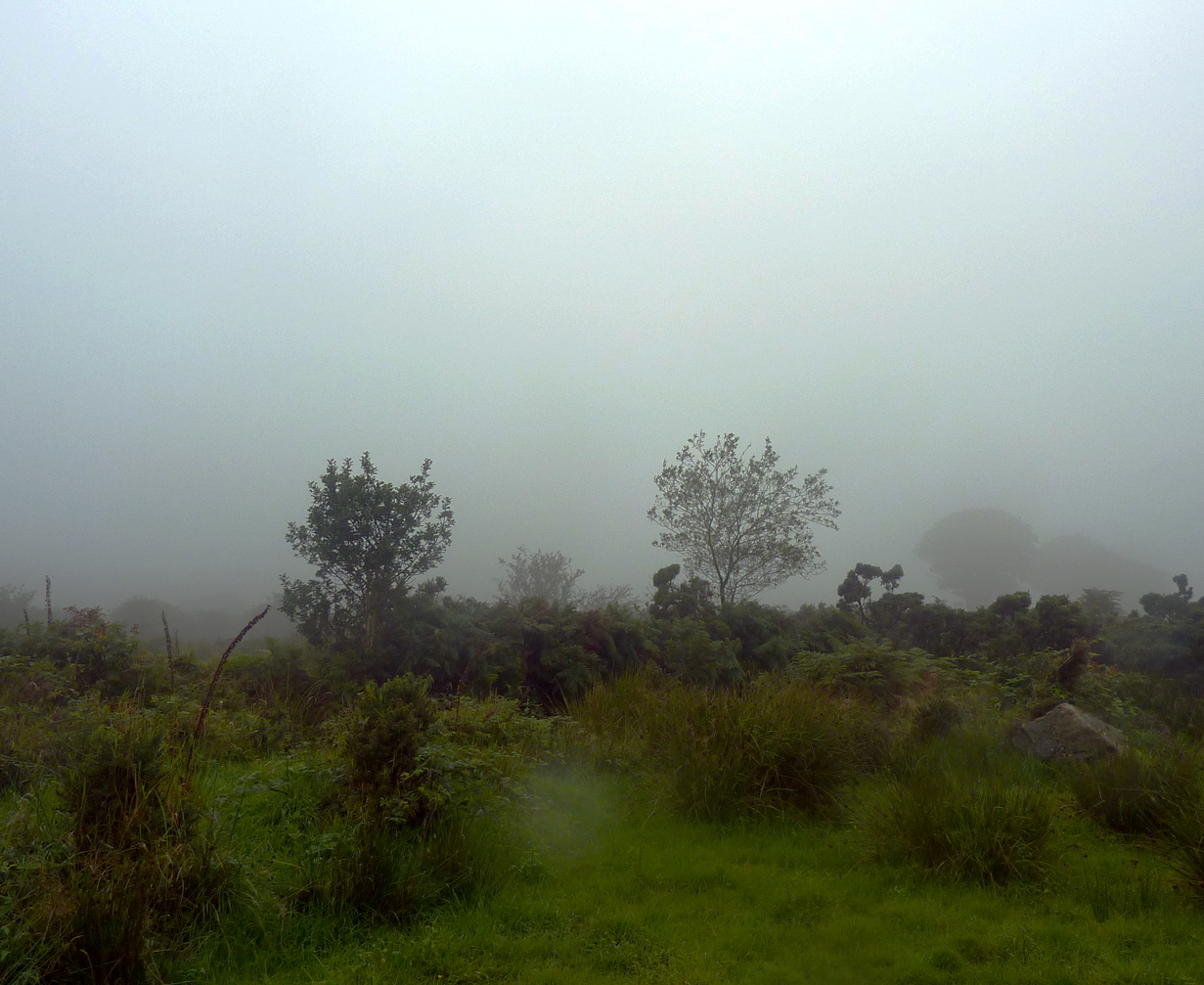
This is an example of one of the photographs I often use, It was taken in a foggy Dartmoor. This image of trees appearing through mist is compelling. It looms, it is ghostly, it shadows in an inverse way. Landscapes have different emotional vibrations and here I am drawn to the ghostly loomings in the misty hinterland. It is suggestive of loss, and the desire to make loss visible. For what is a ghost if not something lost made visible? Rainfall and mist are ciphers for new kinds of diffused light. Clare describes mist often:
’Like fallen clouds that spread – and things retire’
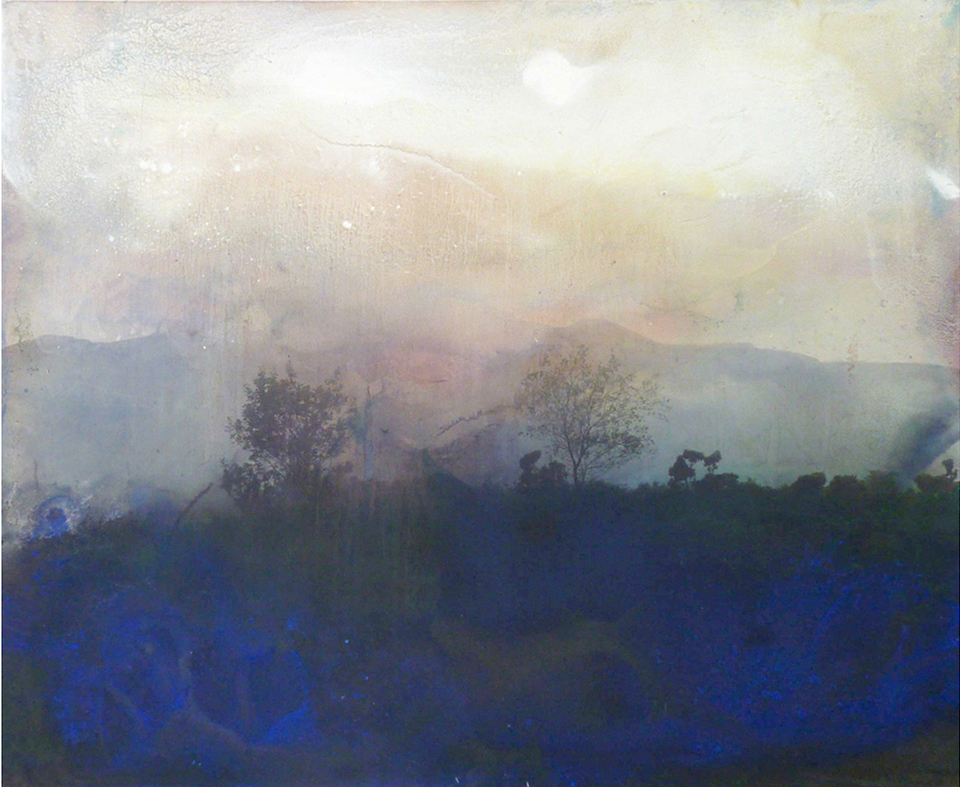
Trees ii 114.3 cm x 139.7 giclee print, pigment, sand and acrylic on canvas.
Working with puddles means that I get to know water tension, how the skin over a puddle holds the colour and how this will dry, leaving a tide line at the edge where the pigment gathered. Water tensions can also be broken and then a wonderful bleed diffuses the surface. There is a strong element of the unpredictable as drying pools and runs constantly change and shrink.
So I see it as an attempt to engage with the processes of nature. The physics of fluid flow, gravity, the weight of mud dripping and water flowing through it. Blooms of paint bleed into water and proliferate into myriads of capillaries. Tide marks and striations etch themselves where the drying paint pulls back.
I don’t paint so much as facilitate the alchemy and movement of nature in the interacting materials. Watching and manipulating these washes and pools as they dry is key to my practice, enabling me to witness nature unfurl.
I think of my painting as combining various layers of nature. The technologicical aspect of the photograph, the physics of natural reactions in the materials, and my own nature in watching and doing. These elements eventually coalesce as a new image emerges.
There is an intermediate phase between the photographs and the paintings. Digital sketches are where I experiment with layering over the photographs on my lap top to try and give an indication of what I can do with paint. Working with paint and working in photoshop are never remotely similar but these sketches give me pointers that help lead to the final work. This is one of a series made were made using landscapes photographed at John Clare’s Swordy Well.
‘Doubling ii’ Giclee print 2014
Layering, loss – obliteration via darkness or the whiteout of mist.
I’m interested in darkness in nature. Depths and layers of darkness – the unknown and what you might imagine there.
Clare was interested in light, in shadows, light falling away, glistening or darkening – and these words become metaphors for emotional states. In the same way, in my paintings the quality of light is a conduit for a particular emotional narrative. Things are clear, bright, psychedelic even, or they are veiled, blinded and obtuse.
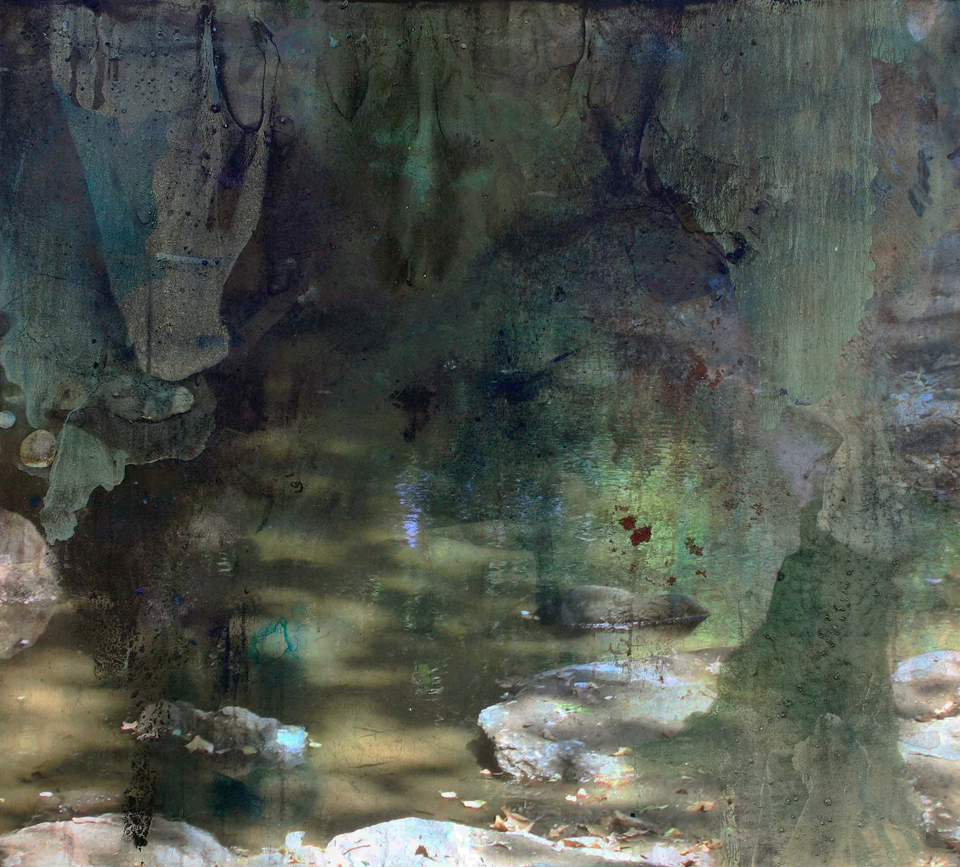
dark water 2008 114.3cm x 127cm giclee print, pigment and acrylic on canvas
The painting above looks at layering leading to darkness, and the one below has layers of whiteout and mist. I think it has aspects of the ghostly loomings that I referred to earlier. It was painted in a year of personal debilitating loss. Clare’s psychological stability depended on an anchored relationship to the natural environment, and the fragmentation of this was a factor that led to his mental illness. There are surely echoes of this in all of us.
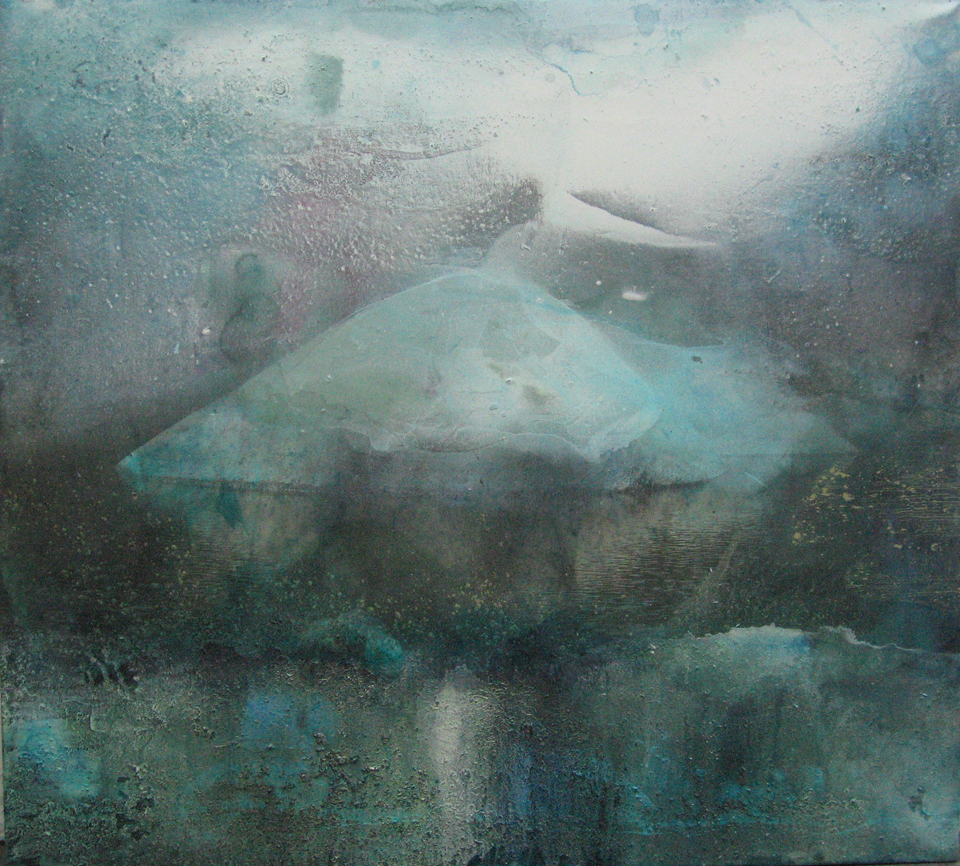
stone in water 114.3cm x 127cm giclee print, pigment and acrylic on canvas
We each have our individual natural history, the biography of our relationship to nature. Mine was of a childhood in rural Suffolk. I was jolted out of this by a move to the outskirts of Cambridge when I was 11 which I was disproportionally traumatised by. I am empathetic therefore with Clare’s re-location to Northborough and the extent to which he was affected even by such a seemingly small move. At 19 I made the decision go to Art School in London and I have remained there more or less ever since. My history is fragmented and now predominantly urban, making ‘visits’ to nature rather than living in it. This lack of close proximity without doubt informs the quality of nature in my work today.
The situ of John Clare’s story, and my own, is of initial immersion in nature and then dislocation. His childhood was happy and immersed in rural life. Then there was the enclosures, the development of this poetic voice, his successes lauded with his visits to London and then depression, domestic stresses and incarceration at High Beech Asylum. His iconic journey home from Essex was followed by his final years in Northampton Asylum. It is not surprising that he has been taken as a poetic symbol for the environmental moment and an example what can come about when nature is damaged and people lose an essential part of their relationship to it. He was graced with an extraordinary love of nature and place, and when this was disrupted, the damage to him was extreme, commensurate with the intensity of his love.
John Clare found poems in the fields and kicked them out of clods suggesting that he is fused with nature, and that his voice is almost nature’s voice. This idea that creativity itself arises out of nature aligns him with Williams Blake’s thought that
“- – – to the eyes of the man of imagination, nature is imagination itself.“….
When humans have a closeness with nature they tend to understand the language of beauty. What is noticeable now, is how our decreasing contact with the natural world results in a diminishing of visual sensibility. The ability to respond to and be moved by the language of colour, form and light, and to allow those things to play into the imagination, is eroded.
If our increasingly urban and technologically orientated lives lead to a loss of sensitivity to nature, they also lead, progressively to an inability to read visual language in painting.
The poems and indeed the life of John Clare can help with how we think about these things and through his work, we can revisit, renew and re-imagine our place in nature.
